8 Practical Ways To Make Your Home Noise-Free
Constant exposure to extreme sounds can result in hearing loss. It can also decrease the sensitivity of your auditory system to detect small sounds. By sound-proofing your home, you can limit the negative consequences of noise pollution on your health. There are various techniques to make your home noise-free, such as reinforcing your building’s fabric and installing noise-reduction doors and windows. Try these other practical ways to achieve the desired result.
Upgrade your windows

Replacing your windows may seem costly initially, but the investment would pay off in the long run. You can drastically minimize external noise by upgrading to double or triple-paned windows with PVC frames. Noise-limiting windows may use special glass to disrupt soundwaves and block external noise as they travel through the material. For better sound-proofing results, try using a layered effect. For example, planting shrubs outside your window and installing noise-reduction shutters can block out traffic noise, so keep this in mind.
Use noise-canceling headphones and earplugs
Noise-canceling headphones are great devices for blocking out unwanted sounds at home. These tools are also recommended for industrial and construction workers who want to filter unwanted noise. Wearing earplugs and earmuffs can help you regulate loud noises to safer levels. You can fit earplugs in your ear canal or wear earmuffs on your entire outer ear, forming a seal that protects your hearing system.
Notify authorities about noise pollution
It's important for homeowners to regularly ensure indoor noise levels are within acceptable limits. The average noise limit is 55dB and 30dB for daytime and nighttime, respectively, to avoid adverse effects on health. You can report people who infringe on noise regulations to local government authorities so that it can be amicably resolved.
Holding noise makers accountable for their actions is one way to control your exposure to unpleasant sounds. Therefore, create noise pollution awareness in your community. This way, everyone can play their part in ensuring the neighborhood is calm.
Invest in sound-dampening curtains
Noise-dampening curtains are designed from dense fabrics and come with a series of layers to minimize sound transmission via your windows. These curtains work by reducing noise reverberations in your home. You can block even more noise by ensuring that your curtains cover all wall surfaces above and below your windows, so feel free to consider this. While you seek functionality, you don’t want to sacrifice aesthetic appeal. Therefore, ensure you invest in sound-dampening curtains that blend seamlessly with your interior design.
Insulate your ceilings and walls
Insulation techniques are among the practical ways to build a noise-free home, as it blocks sound vibrations and reduce noise intensity. You can boost your insulation by incorporating soundproofing materials into your walls, ceilings, and floor. Insulation materials like ceiling panels, viscoelastic foams, and mass-loaded vinyl can reduce the level of sound coming in or out of your home. However, this task is best left to the professionals.
Fortunately, companies like All Florida Insulation can effectively soundproof your house with fiberglass and spray foam insulation, depending on your preferences. Aside from noise reduction, properly insulating your home can increase your energy efficiency, so keep this in mind.
Build a barrier
This may sound extreme, but it's another practical strategy to curb noise pollution. Noise is created by strong sound vibrations, which can be greatly reduced by building a barrier or fence. A fence will help absorb sound waves or vibrations, preventing them from penetrating your home.
Consider buying sound-friendly furniture
Furniture is a good absorber of sounds; they limit echo and sound vibrations. Therefore, consider buying sound-proof chairs, cabinets, and couches, as they can impact acoustics in your home. For example, if your next-door neighbor frequently disturbs you with loud sounds, you can place a bookshelf against the shared wall facing their room to reduce the impact. Furthermore, it's possible to control excess noise using soft furnishings like rugs, carpets, and wall hangings.
Switch off noisy devices or lower the volume

Home appliances, such as laptops, television sets, and woofers, can cause noise pollution when operated at high volumes. It is advisable to switch them off when not in use.
Doing this doesn't only protect your ears; you would also be cutting down your energy bills. If switching them off isn’t an option, consider reducing their volume. To reduce noise intensity, you can also place padding under kitchen equipment, such as your blender.
Noise pollution is regarded as an environmental challenge, but you can control it with the right tips. Follow these practical tips to create a noise-free home.
